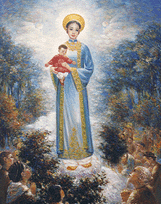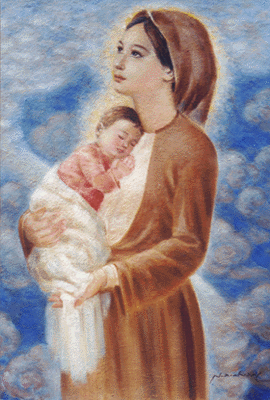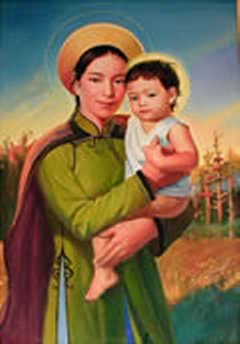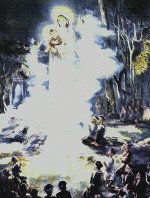Our Lady of Lavang - La'Vang, Vietnam (1798)
During much of the 18th century, the nation of Vietnam was embattled in various struggles for power and domination. The northern regions of the kingdom fell under the authority of the lords of the Trinh family, while in the southern realm the Nguyen lords took power. As the eighteenth century drew toward its close, both of their rules were shaken and threatened by peasant uprisings and emerging rebel forces.
The strongest among the many uprisings was led by the three brothers from Tay Son. In short order, they overthrew the Nguyen lords and defeated the Trinh lords to restore national unity for the first time since the decline of the Le dynasty. A Tay Son brother was enthroned to be King Quang Trung. In 1792 he passed away and left the throne to his son who became King Canh Thinh.
Meanwhile, Nguyen Anh continued his insurgency in trying to reclaim his throne. Earlier in his run from the Tay Son rebels in 1777, he found refuge on Phu Quoc Island, where Monsignor Pierre Pigneau de Behaine of the Society of Foreign Missions directed a seminary for youths from neighboring countries. The bishop persuaded him to seek help from King Louis XVI of France.
King Canh Thinh knew that Nguyen Anh received support from the French missionary and worried that the Vietnamese Catholics would also endorse his reign. He began to restrict the practice of Catholicism in the country. On August 17, 1798, King Canh Thinh issued an anti-Catholic edict and an order to destroy all Catholic churches and seminaries. A most grievous persecution of Vietnamese Catholics and missionaries began and lasted until 1886. Even after Nguyen Anh succeeded in reclaiming his throne as King Gia Long (1802-1820), his successors, King Minh Mang (1820-1840), King Thieu Tri (1841-1847) and King Tu Duc (1847-1884), the last Nguyen emperor, continued the vehement campaign against Catholics, ordering punishments that ranged from branding their faces to death by various cruel methods for Vietnamese Catholics and missionary priests.
It was amidst this great suffering that the Lady of Lavang came to the people of Vietnam. The name Lavang was believed to be originated in the name of the deep forest in the central region of Vietnam (now known as Quang Tri City) where there was an abundance of a kind of trees named La' Vang. It was also said that its name came from the Vietnamese meaning of the word "Crying Out" to denote the cries for help of people being persecuted.
The first apparition of the Lady of Lavang was noted in 1798, when the persecution of Vietnamese Catholics began. Many Catholics from the nearby town of Quang Tri sought refuge in the deep forest of Lavang. A great number of these people suffered from the bitter cold weather, lurking wild beasts, jungle sickness and starvation. At night, they often gathered in small groups to say the rosary and to pray. Unexpectedly, one night they were visited by an apparition of a beautiful Lady in a long cape, holding a child in her arms, with two angels at her sides. The people recognized the Lady as Our Blessed Mother.
Our Blessed Mother comforted them and told them to boil the leaves from the surrounding trees to use as medicine. She also told them that from that day on, all those who came to this place to pray, would get their prayers heard and answered. This took place on the grass area near the big ancient banyan tree where the refugees were praying. All those who were present witnessed this miracle. After this first apparition, the Blessed Mother continued to appear to the people in this same place many times throughout the period of nearly one hundred years of religious persecution. Among many groups of Vietnamese Catholics that were burnt alive because of their faith was a group of 30 people who were seized after they came out of their hiding place in the forest of Lavang. At their request, they were taken back to the little chapel of Lavang and were immolated there on its ground.
From the time the Lady of Lavang first appeared, the people who took refuge there erected a small and desolate chapel in her honor. During the following years, Her name was spread among the people in the region to other places. Despite its isolated location in the high mountains, groups of people continued to find ways to penetrate the deep and dangerous jungle to worship the Lady of Lavang. Gradually, the pilgrims that came with axes, spears, canes, and drums to scare away wild animals were replaced by those holding flying flags, flowers and rosaries. The pilgrimages went on every year despite the continuous persecution campaigns.
In 1886, after the persecution had officially ended, Bishop Gaspar ordered a church to be built in honor of the Lady of Lavang. Because of its precarious location and limited funding, it took 15 years for the completion of the church of Lavang. It was inaugurated by Bishop Gaspar in a solemn ceremony that participated by over 12,000 people and lasted from August 6th to 8th, 1901. The bishop proclaimed the Lady of Lavang as the Protectorate of the Catholics. In 1928, a larger church was built to accommodate the increasing number of pilgrims. This church was destroyed in the summer of 1972 during the Vietnam war.
The history of the Lady of Lavang continues to gain greater significance as more claims from people whose prayers were answered were validated. In April of 1961, the Council of Vietnamese Bishops selected the holy church of Lavang as the National Sacred Marian Center . In August of 1962, Pope John XXIII elevated the church of Lavang to The Basilica of Lavang. On June 19, 1988, Pope John Paul II in the canonizing ceremony of the 117 Vietnamese martyrs, publicly and repeatedly recognized the importance and significance of the Lady of Lavang and expressed a desire for the rebuilding of the Lavang Basilica to commemorate the 200th anniversary of the first apparition of the Lady of Lavang in August of 1998.



